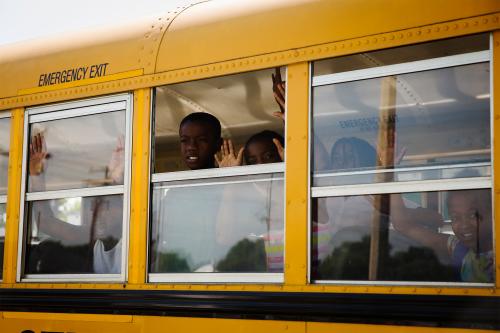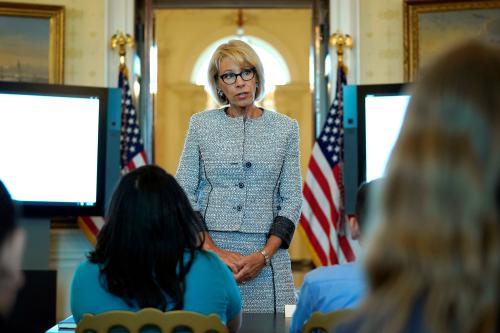This post originally appeared in The Hechinger Report; the version below has been lightly edited for style and content.
Ever since enslaved Black people arrived on the shores of the English colony of Virginia in 1619, white legislators at various levels of government have designed laws to explicitly control and suppress Black communities. In 1857, in its Dred Scott decision, the Supreme Court decided that Black people were not citizens and did not have the right to sue in federal court. Our bondage continued even after the abolition of slavery in 1865: Southern states legislated “Black Codes” immediately after the Civil War, denying Black people the right to vote and restricting their movement. In some municipalities, called “sundown towns,” Black individuals were not allowed to enter after dark. “Whites only” signs littered public spaces throughout the 20th century. It was illegal in so many ways for Black people to simply be in a country supposedly built on the unalienable, natural rights of “life, liberty, and the pursuit of happiness.”
When racism is the overarching, unwritten law of the land, any and every rule can and will be used to control Black people. Those who would have us return to a period of legal segregation don’t need to bring back signposts to separate us when they can discriminate in other ways, simply on the basis of how we look, how we dress, and how we wear our hair. When dress and grooming codes reinforce white norms, being Black becomes a violation.
In December 2019, Barbers Hill Independent School District in Mont Belvieu, Texas, a suburb east of Houston, decided to begin enforcing a dress code policy that’s been on the books for 30 years. The policy includes sections on clothing, head coverings, and hair: “Male students’ hair will not extend, at any time, below the eyebrows, or below the ear lobes. Male students’ hair must not extend below the top of a t-shirt collar or be gathered or worn in a style that would allow the hair to extend below the top of a t-shirt collar, below the eyebrows, or below the ear lobes when let down.”
DeAndre Arnold has attended the Barbers Hill Independent School District his entire life; in high school, he grew his hair into locks. However, before winter break, the principal of Barbers Hill High School placed DeAndre, a senior, in in-school suspension and told him that he would not be able to attend classes, prom, or even his graduation. Why? Because his dreadlocks violated the dress code. To notify DeAndre months before graduation that he was being suspended for his hair doesn’t make much sense, but racism isn’t logical.
The school district has 5,379 students, of which roughly 70% are white, more than a fifth are Hispanic, just 3% are Black, and nearly 4% come from another racial background. The communities that feed in to Mont Belvieu—Old River-Winfree, Cove, and Beach City—are all around 90% white, according to the latest census data.
“DeAndre (and) his family should not have to go through this. But I expect it from a board that has zero diversity,” Gerry Monroe, a representative of the community activism organization the United Urban Alumni Association, told the school board at a recent meeting.
Clearly, representation matters. Research has shown that diverse decision-making bodies are better problem-solvers than homogenous ones. The lived experience of Black folk shows that all-white decision-making bodies enforce racial biases and stereotypes. Having a racially diverse board would protect against the racist enforcement of dress codes such as Barbers’. Though we do not know the racial composition of the district’s board for sure, their decision to suspend DeAndre lays bare their desire to control Black bodies.
In response to news stories about the school’s decision to suspend DeAndre, the Barbers Hill superintendent tweeted that it’s important to hold Black students to high expectations, implying that dreadlocks are linked to bad performance. Except hair has nothing to do with academic standards or college readiness. The frivolous use of this dress code to prevent students from graduating is about exerting authority over and controlling Black people. Black people should not, cannot change themselves to fit white norms.
The laws have changed, and segregation-era poster boards and signs have evolved; today, people create dress codes that discriminate against Black students’ natural hair. In March 2018, Tenaya Middle School officials in Fresno, California, pulled a 14-year-old male student out of class for a haircut with shaved-in designs. Citing a dress code policy, they separated him from other students and prevented him from going to lunch with his peers because they feared it would be too “distracting.” In 2013, Deborah Brown Community School, in Tulsa, Oklahoma, sent Tiana Parker home after telling the 7-year-old that her locks did not look “presentable.” In 2016, The School for Creative Studies, in Durham, North Carolina, prevented Black students from wearing traditional head wraps, or geles, a symbol used to represent the students’ connection with Africa—during Black History Month, no less! Mystic Valley Regional Charter School in Malden, Massachusetts, gave multiple detentions to twin sisters Deanna and Mya Cook for their hair extensions and prevented them from attending their junior prom in 2017.
School districts are not the only entities hiding their racism behind laws that provide cover. In 2017, the 11th Circuit Court of Appeals ruled that a “race-neutral grooming policy” used to justify rescinding a job offer to a woman who wore locks was not discriminatory, because hairstyles, while “culturally associated with race,” are not “immutable physical characteristics.” The Supreme Court refused to hear the appeal. Rep. Cedric L. Richmond (D-La.) and Sen. Cory Booker (D-N.J.) introduced companion bills last year in the House and Senate, expressly prohibiting discrimination based upon natural hair or hairstyles like twists and extensions that protect natural hair from weather, over-washing, and processing. Booker’s interest was piqued after 16-year-old New Jersey wrestler, Andrew Johnson, was ordered by a referee in 2018 to cut his dreadlocks or forfeit his match. Last year, California became the first state to ban workplace and school discrimination against Black people for wearing hairstyles such as braids, twists, and locks. New York followed shortly after.
DeAndre Arnold’s suspension is rightly receiving the national attention it deserves. Actress Gabrielle Union and retired NBA player Dwyane Wade, producers of the Oscar-nominated animated short film “Hair Love,” made DeAndre their plus-one to the 92nd Academy Awards last week. Forced to choose between cutting his hair and attending graduation, DeAndre chose to transfer to another school.
“We’re here for DeAndre, but it’s about more than that,” DeAndre’s mother, Sandy Arnold, told the Associated Press. “This is about all the other DeAndres that could come through Barbers Hill.”
Since DeAndre transferred to another school, television news station KHOU 11 has reported that the principal disciplined DeAndre’s cousin, sophomore Kaden Bradford, for violating the grooming policy. Like DeAndre, Kaden wears his hair in locks. He has been in in-school suspension since Jan. 31.
To have a backward rule around hair length for boys is bad enough, but the way the policy seems to target Black students is even worse. Singling out Black youth with long hair for punishment shows how prejudiced school officials will do anything, apply any rule, to achieve a bigoted result.






Commentary
School dress and grooming codes are the new ‘whites only’ signs
February 14, 2020